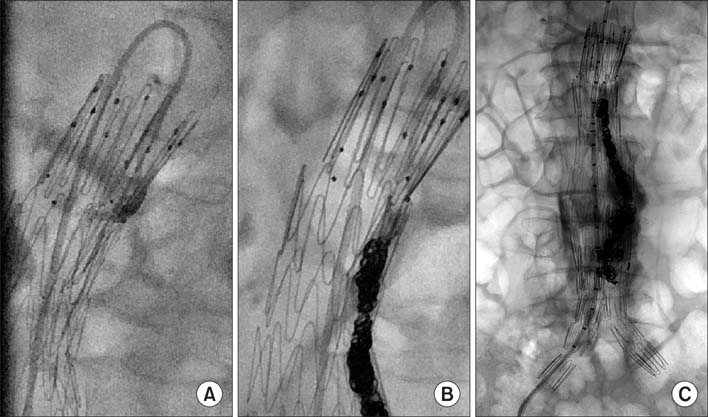Ann Surg Treat Res.
2014 Feb;86(2):95-99. 10.4174/astr.2014.86.2.95.
Clinical significance of type I endoleak on completion angiography
- Affiliations
-
- 1Department of Surgery, Seoul National University College of Medicine, Seoul, Korea. skminmd@snuh.org
- 2Department of Radiology, Seoul National University College of Medicine, Seoul, Korea.
- KMID: 1908504
- DOI: http://doi.org/10.4174/astr.2014.86.2.95
Abstract
- PURPOSE
Type I endoleak is known to be associated with sac enlargement and occasional rupture, therefore, the treatment of type I endoleak is recommended at the time of diagnosis. The aim of this study was to identify the significance of early type I endoleak found on completion angiography.
METHODS
Between January 2000 and December 2012, a total of 86 patients underwent endovascular abdominal aortic aneurysm repair (EVAR) and 10 patients (11.6%) were diagnosed with type Ia endoleak on completion angiography. Clinical and radiologic data were reviewed retrospectively.
RESULTS
Of the 10 patients, two underwent EVAR with custom-made stent-grafts in the initial stage and both of them needed immediate treatment: one case involved open repair while the other involved insertion of an additional stent-graft. In 8 patients, the amount of leakage decreased after repeated balloon molding. They were managed conservatively and followed up with computed tomography angiography within 2 weeks after EVAR. In 7 of the 8 cases, type Ia endoleaks disappeared. In one patient with a persistent endoleak and a folded posterior wall of the stent-graft, coil embolization was performed 1 week after EVAR. With a median follow-up of 12 months (range, 1-61 months), no patients showed recurrence of type I endoleak or sac expansion.
CONCLUSION
Type I endoleaks diagnosed on completion angiography sealed spontaneously in 7 of 10 patients (70.0%). In cases of decreased amounts of leakage after balloon molding, simple observation may be an alternative to repetitive procedures. The long-term follow-up of patients with self-sealed type I endoleaks is mandatory.
MeSH Terms
Figure
Reference
-
1. Patel VI, Lancaster RT, Mukhopadhyay S, Aranson NJ, Conrad MF, LaMuraglia GM, et al. Impact of chronic kidney disease on outcomes after abdominal aortic aneurysm repair. J Vasc Surg. 2012; 56:1206–1213.2. EVAR trial participants. Endovascular aneurysm repair versus open repair in patients with abdominal aortic aneurysm (EVAR trial 1): randomised controlled trial. Lancet. 2005; 365:2179–2186.3. EVAR trial participants. Endovascular aneurysm repair and outcome in patients unfit for open repair of abdominal aortic aneurysm (EVAR trial 2): randomised controlled trial. Lancet. 2005; 365:2187–2192.4. Pitoulias GA, Schulte S, Donas KP, Horsch S. Secondary endovascular and conversion procedures for failed endovascular abdominal aortic aneurysm repair: can we still be optimistic? Vascular. 2009; 17:15–22.5. Mehta M, Sternbach Y, Taggert JB, Kreienberg PB, Roddy SP, Paty PS, et al. Long-term outcomes of secondary procedures after endovascular aneurysm repair. J Vasc Surg. 2010; 52:1442–1449.6. Venermo MA, Arko FR 3rd, Salenius JP, Saarinen JP, Zvaigzne A, Zarins CK. EVAR may reduce the risk of aneurysm rupture despite persisting type Ia endoleaks. J Endovasc Ther. 2011; 18:676–682.7. Veith FJ, Baum RA, Ohki T, Amor M, Adiseshiah M, Blankensteijn JD, et al. Nature and significance of endoleaks and endotension: summary of opinions expressed at an international conference. J Vasc Surg. 2002; 35:1029–1035.8. Harris PL, Vallabhaneni SR, Desgranges P, Becquemin JP, van Marrewijk C, Laheij RJ. Incidence and risk factors of late rupture, conversion, and death after endovascular repair of infrarenal aortic aneurysms: the EUROSTAR experience European Collaborators on Stent/graft techniques for aortic aneurysm repair. J Vasc Surg. 2000; 32:739–749.9. Naughton PA, Garcia-Toca M, Rodriguez HE, Keeling AN, Resnick SA, Morasch MD, et al. Endovascular treatment of delayed type 1 and 3 endoleaks. Cardiovasc Intervent Radiol. 2011; 34:751–757.10. Matsumura JS, Moore WS. Clinical consequences of periprosthetic leak after endovascular repair of abdominal aortic aneurysm. Endovascular Technologies Investigators. J Vasc Surg. 1998; 27:606–613.11. Buth J, Harris PL, van Marrewijk C, Fransen G. The significance and management of different types of endoleaks. Semin Vasc Surg. 2003; 16:95–102.12. Cronenwett JL, Johnston KW. Rutherford's vascular surgery. 7th ed. Philadelphia: Saunders;2009.13. Broeders IA, Blankensteijn JD, Gvakharia A, May J, Bell PR, Swedenborg J, et al. The efficacy of transfemoral endovascular aneurysm management: a study on size changes of the abdominal aorta during mid-term follow-up. Eur J Vasc Endovasc Surg. 1997; 14:84–90.14. Sampaio SM, Panneton JM, Mozes GI, Andrews JC, Bower TC, Karla M, et al. Proximal type I endoleak after endovascular abdominal aortic aneurysm repair: predictive factors. Ann Vasc Surg. 2004; 18:621–628.15. Zayed HA, Attia R, Modarai B, Clough RE, Bell RE, Carrell T, et al. Predictors of reintervention after endovascular repair of isolated iliac artery aneurysm. Cardiovasc Intervent Radiol. 2011; 34:61–66.16. Sampaio SM, Shin SH, Panneton JM, Andrews JC, Bower TC, Cherry KJ, et al. Intraoperative endoleak during EVAR: frequency, nature, and significance. Vasc Endovascular Surg. 2009; 43:352–359.17. Zayed HA, Bell RE, Clough RE, Thomas S, Sabharwal T, Reidy JF, et al. Results of endovascular repair of abdominal aortic aneurysms with an unfavorable proximal neck using large stent-grafts. Cardiovasc Intervent Radiol. 2009; 32:1161–1164.
- Full Text Links
- Actions
-
Cited
- CITED
-
- Close
- Share
- Similar articles
-
- Late Type 3b Endoleak Mimicking Type 2 Endoleak after Endovascular Aortic Aneurysm Repair
- Adjunctive Procedure as Treatment of Type I Endoleak after EVAR
- Successful treatment of type I endoleak of common iliac artery with balloon expandable stent (Palmaz XL stent) during endovascular aneurysm repair
- Experience of Endovascular Aneurysm Repair in Abdominal Aortic Aneurysm
- Concurrent Occurrence of Type II and Type III Endoleak of Abdominal Aortic Aneurysm Stent Graft: A Case Report



